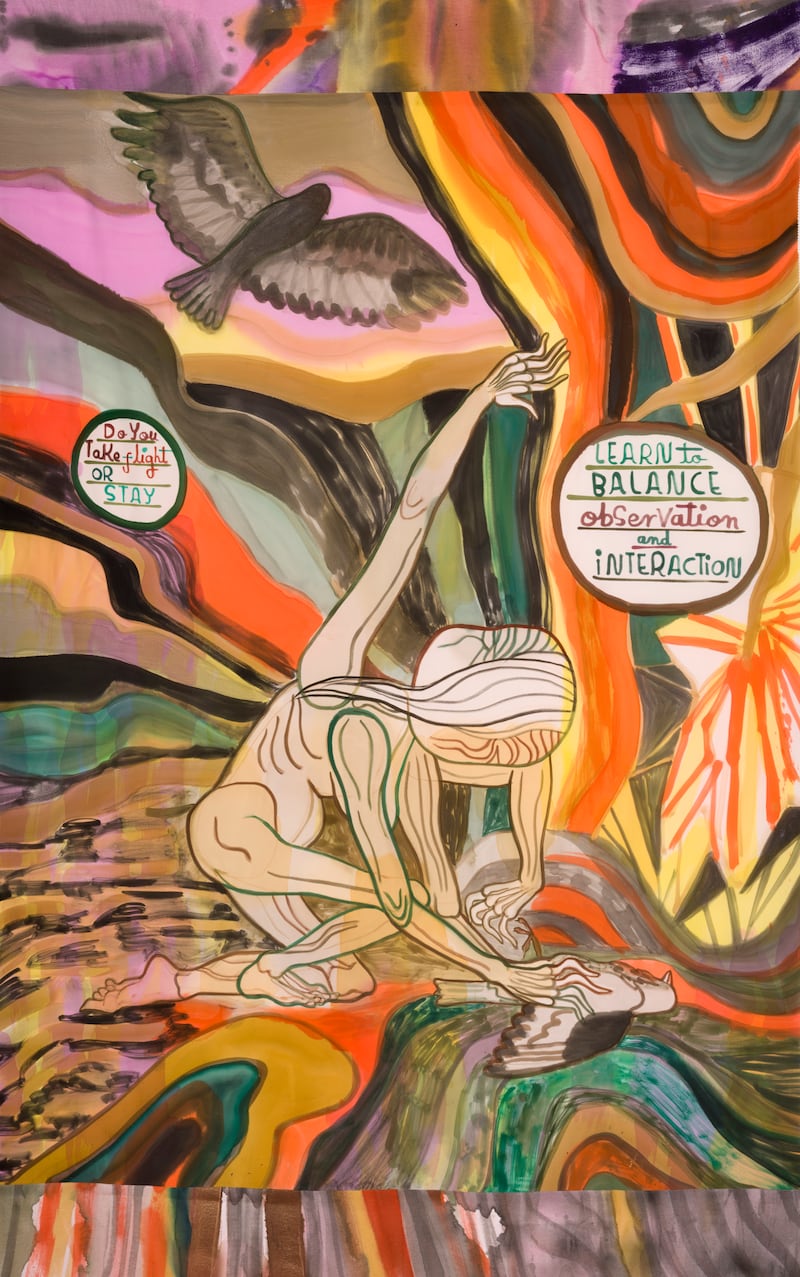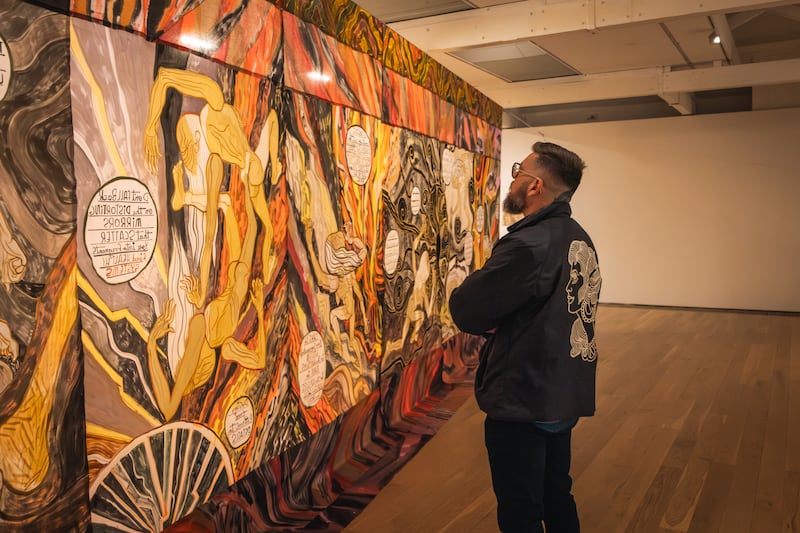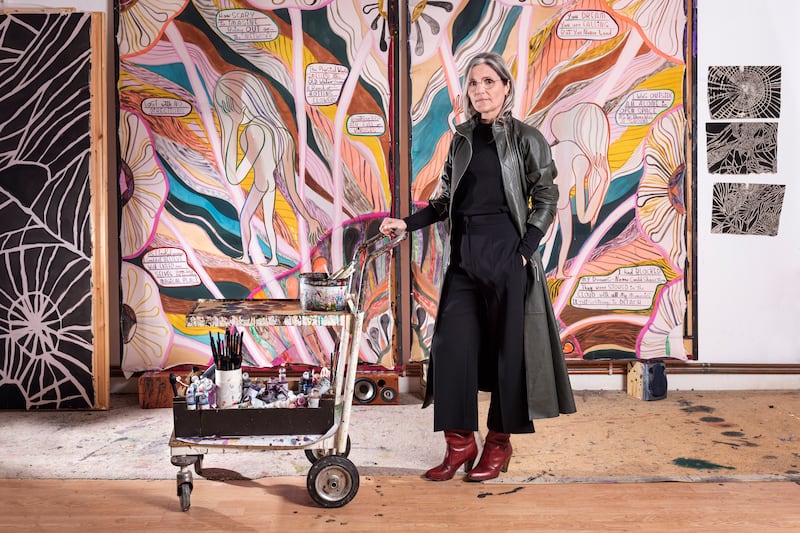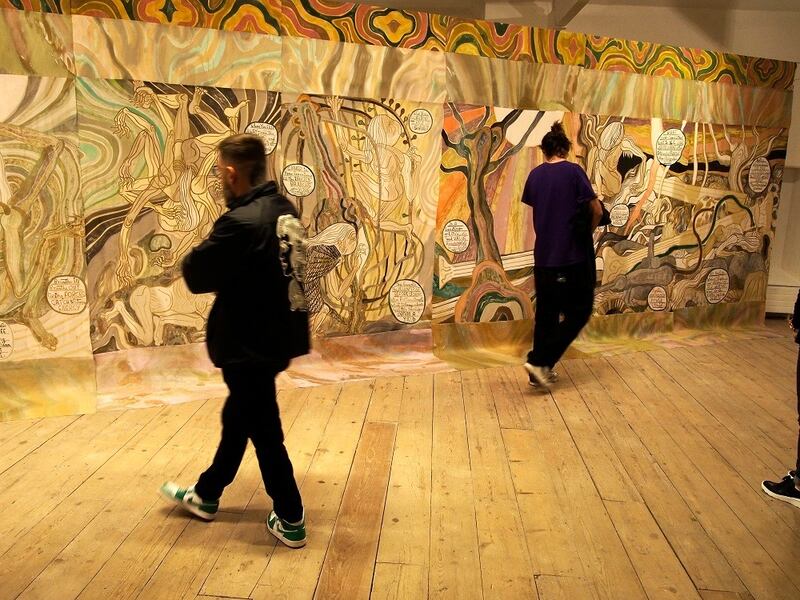“I draw to see what I’m thinking,” says Emma Talbot, whose monumental The Age/L’Età is currently installed at the Model gallery in Sligo. Talbot is a fascinating artist who turns ideas and conventions on their head to create work that presents us with a series of what-ifs. Through her eyes, we can consider what if monumental could actually be huge-but-delicate painted-silk hangings? What if monumental were made in watercolour and knitting? And what if the central heroic figure in an epic narrative were actually an elderly woman with long silver hair?
While previous projects have explored topics including identity in the face of shifting gender roles, grief and the extraordinary power of plants, the central theme of The Age is climate change. Still, if you were expecting an exhibition that was didactic, preachy or otherwise po-faced, you’re in for a welcome surprise. Presented like a graphic novel, albeit one that is painted on a vast scale, and with extraordinary dynamic grace, The Age follows its hero through a journey based on both the mythical 12 Labours of Hercules (also known as the 12 Trials) and the perhaps more useful 12 principles of permaculture, which include integrating rather than segregating, designing from patterns to details, self-regulation and accepting feedback.
It is not lost on Talbot that whereas the former is all about solving problems with force and violence, the latter calls for refection, empathy and care. There are other sources too: the whole installation borrows its name from The Three Ages/Le Tre Età, painted by Gustav Klimt in 1905. Its composition fascinated Talbot, showing three women: a mother cradles her baby beneath the hunched figure of an older woman, her head bowed, a hand covering her face.

“When I saw it originally, I connected to it, probably because she’s got grey hair, about this long,” says Talbot, gesturing via Zoom to her own silvered hair. Klimt’s work haunted her. “I kept thinking about it. I’m thinking, I don’t like this spectre of the elderly woman. She’s naked, and presented in a way which is horrifying. It’s almost as if you’re looking at a cadaver. What you’re meant to feel is a kind of disgust.”
Talbot is an artist who thinks deeply, and with Klimt’s painting rooted firmly in her mind she pondered the possibilities. It had been acquired by the Italian national gallery, in Rome, to celebrate 50 years of the unification of Italy. “It seemed a really bizarre image to choose,” she says. Maybe, she thought, the younger figures represented modernity and the future, while the older woman stood for older, traditional or more superstitious beliefs. She definitely seemed to stand for shame.
And yet, Talbot realised, as we face the current climate catastrophe, more traditional ideas are being reclaimed. “Right now we’re looking to alternative methods, ways of thinking and relationships to nature. We’re looking for these things that were once abandoned.” In her retelling, through the panels of The Age, the elderly woman becomes a survivor who can bring knowledge and wisdom to the present to create new possibility. “When we think of the future we think of it as a young thing, but if we’re lucky we’ll all be older in the future. So the future could be an older thing.”
[ Andy Warhol works set for Gormley’s pop art showcaseOpens in new window ]
Talbot took these ideas and knitted them together to create a proposal for the Max Mara Art Prize for Women, a major award given every two years, which includes a six-month residency in Italy, leading up to a pair of exhibitions: at Whitechapel Gallery in London and at the Collezione Maramotti in Reggio Emilia, Italy.
Travelling to Italy to take up the award in 2021, Talbot spent time living with a permaculture community, as well as researching the stories of Hercules, and creating her extraordinary work. The prize marked a period of success and change for the artist, who was born in the UK in 1969. She made the move to Italy permanent, although she says post-Brexit visa issues took a long time to resolve. She created a major installation for the Arsenale at the 2022 Venice Biennale. Drawing on Paul Gaugin’s Tahitian painting from 1897, Talbot’s Where Do We Come From, What Are We, Where Are We Going? addresses our own escapist fantasies and desires, in paintings on silk that have been described as ecstatic.
She also made another silk-hanging installation, this time for Frieze London; 21st Century Herbal was inspired by medieval manuscripts that detail the medicinal (and toxic) properties of plants. In an interview with Frieze at the time, she said she wanted the installation to “feel like walking along through a garden full of knowledge”.

Powerful works of art lend themselves to confluences, calling to mind other artists whose work picks up on similar themes, or who explore things in similar ways. Urgent ideas find their time, and it is interesting to see 21st Century Herbal echoed in The Grove, created by Navine G Dossos at the Limerick cafe of the same name, for this year’s EVA International. EVA ended on October 29th, but you can still sit among Dossos’s murals and discover fascinating facts about plants and herbs on the tables of the Cecil Street cafe (where you can also be assured of excellent coffee and cakes).
[ Why the classical world still grips the contemporary imaginationOpens in new window ]
Similarly, Alice Maher and Rachel Fallon’s The Map (2021) draws on mythological themes to rewrite the past and hopefully offer a new future, from a more female perspective, on a huge fabric tapestry. While The Map reimagines the stories, myths and legacies of Mary Magdalene, Talbot’s The Age centres the idea of an Everywoman figure, who is nonetheless based on Talbot herself. Softly spoken, Talbot is eloquent and persuasive. Deeply committed to her work, she is clearly not a woman for half measures, although her approach is always highly considered. She is also a profound thinker, but not in the overbearing way that might otherwise leave you anxious about all the things you don’t know yourself. She also has the rare quality of listening well, absorbing new thoughts, and turning them into something larger as she goes.
“If the future is an older thing, we could make use of this elderly wisdom and knowledge. So I thought if an elderly woman was in the future, as a survivor, what would she – and I was imagining myself, projecting – what would I need to learn and know to survive? I’d need to learn how to grow things, how to do practical things…” Talbot contrasts this with the celebrated feats of Hercules. “He resolves them with acts of aggression. He kills, he steals, he tricks, he colonises. They seem like solutions, but they’re actually just really immediate, aggressive acts.”

She uses the famous example of Hercules being tasked with cleaning the Augean stables in a single day. Housing apparently divinely healthy livestock, the stables hadn’t been mucked out for 30 years. Hercules succeeds by diverting two rivers to wash out the filth. In her work, Talbot uses this task to stand for global pollution. Hercules, she notes, does not solve the problem of the filth; he just washes it forcefully elsewhere. “He doesn’t resolve it. He just goes: Right, there you go. I got it done and I did it overnight.” That idea of “getting things done” is an attitude, she suggests, that echoes through British politics. “It’s very current,” she says, “but the elderly woman wouldn’t think like that.”
[ Art collective create two new murals to highlight debate around 'Public Art Bill'Opens in new window ]
Instead, Talbot’s installation follows her as she focuses on more benevolent solutions. “It’s a thought experiment,” she says. “To put a contemporary issue with each of the trials, and see how this elderly woman might reorganise the way the world works. She is thinking about what would it take to restructure where we get energy from? What would it take to think about putting in place different types of energy, which would resolve things more thoroughly?” Hercules, she suggests, would just kill, but, she concludes, “these problems aren’t simple, so there aren’t simple solutions.” Keen to point out that the complexity isn’t a basic narrative of “if women ran the world”, Talbot says that, instead, it “is about universal issues, and how rooted they are in toxic systems”.
Those toxic systems protect themselves to the extent that “it is difficult for us to even see how problematic they are, and see how difficult it is to dismantle or untangle ourselves from their power”. Simple it may not be, but Talbot’s beautifully complex descriptions of a journey to some possible answers are both mesmerising, and well worth seeing in all their physical glory, on exhibition in Sligo.
Emma Talbot’s The Age/L’Età is at the Model in Sligo until December 2nd











